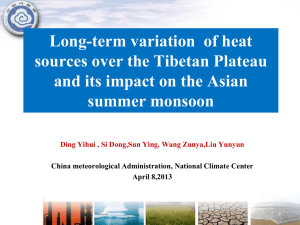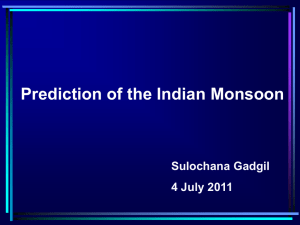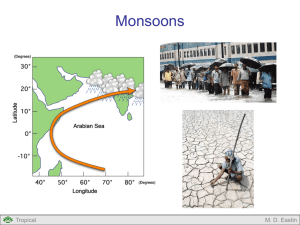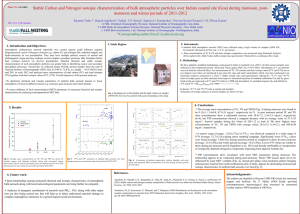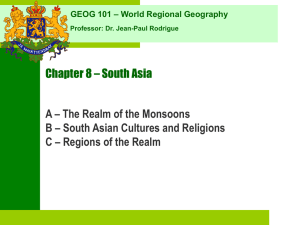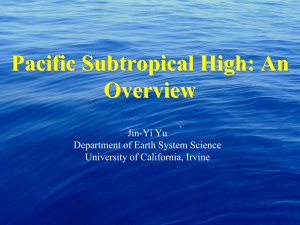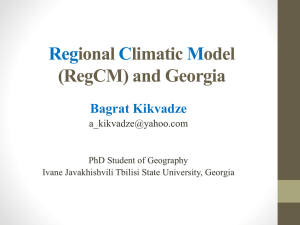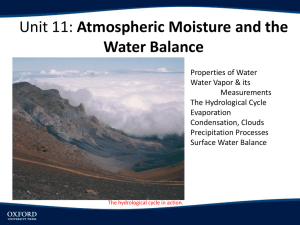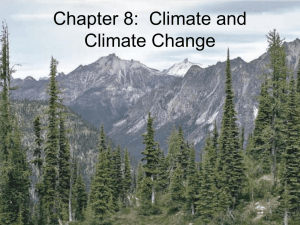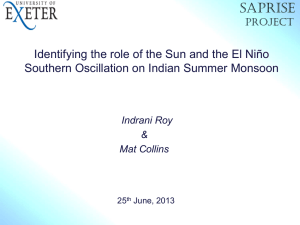Changes in global and regional monsoon precipitation projected by
advertisement
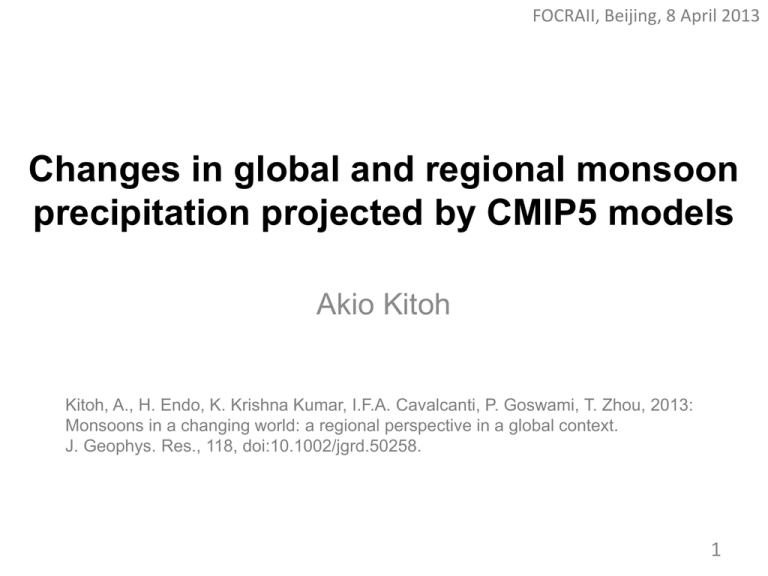
FOCRAII, Beijing, 8 April 2013 Changes in global and regional monsoon precipitation projected by CMIP5 models Akio Kitoh Kitoh, A., H. Endo, K. Krishna Kumar, I.F.A. Cavalcanti, P. Goswami, T. Zhou, 2013: Monsoons in a changing world: a regional perspective in a global context. J. Geophys. Res., 118, doi:10.1002/jgrd.50258. 1 Introduction Monsoons are responsible for the majority of summer rainfall within the tropics, where billions of people depend on the monsoon rainfall. Thus, reliable future projection for monsoon rainfall, especially on a regional-scale, has been strongly demanded. • Provides a latest view of global and regional monsoonal rainfall changes as projected by CMIP5 multi-models. • Investigates not only mean precipitation but also some precipitation extreme indices and monsoon seasonality. 2 Previous studies of the global monsoon Historical records • Decreasing trend in the global land monsoon precipitation over the last half of the 20th century. Wand and Ding (2006); Zhou et al. (2008) • Increasing trend in the combined (oceanic and land) monsoon precipitation for recent decades (1979-2008) Wang et al. (2012) Future projections • Increase of global monsoon area and precipitation intensity. CMIP3: Hsu et al. (2012) CMIP5: Lee and Wang (2012). Hsu et al. (2013) 3 CMIP5 model simulations Analyzed experiments • 20th century historical simulations • 21st century projections under RCP4.5/RCP8.5 scenarios Analyzed models • Monthly output: 29 models • Daily output: 21 models 4 CMIP5 climate model 5 Global monsoon Present-day: 1986-2005 Future: 2080-2099 6 Global monsoon domain • Model mean generally reproduces the observed domain • Some biases over eastern Asia and the tropical Pacific : GPCP : 29 model mean Monsoon domain: Annual range >= 2.5 mm day-1 Annual range: Difference between MJJAS and NDJFM (Wang et al., 2011) 7 Global monsoon domain • Expansion over the central to eastern tropical Pacific, the southern Indian Ocean, and eastern Asia. Reduction Expansion Monsoon domain: Period: 2080 to 2099 Annual range >= 2.5 mm day-1 Annual range: Difference between MJJAS and NDJFM (Wang et al., 2011) 8 Global monsoon precipitation • Multi-model ensemble matches the observations • Monsoon-related precipitation will remarkably increase → consistent with other studies analyzing CMIP3/CMIP5 models Historical RCP4.5 RCP8.5 ×: GPCP/CMAP GMA (ratio to the globe) Large marks: Mean of all models Change ratio [%] GMI by Hsu et al. (2012, 2013); Lee and Wang (2012) RCP4.5 RCP8.5 GMA GMI GMP GMA: Global monsoon (GM) area GMP: GM summer total precipitation GMI: GM intensity (= GMP/GMA) 9 Time series of global land monsoon Change ratio to 1986-2005 av. [%] • Decrease from 1950s to 1980s, and increase in the 21st C • The simulated trend is consistent with the observations but with less amplitude Observations Historical-run RCP4.5 RCP8.5 20-year running mean • Thick line:29 model mean • Shading:29 model spread (10th-90th percentile) Observational data • CRU-TS3.1 • GPCC-v6 • GPCC-VASClimO • CMAP • GPCP 10 Time series of NH/SH land monsoon Change ratio to 1986-2005 av. [%] • Large differences in the amplitude between the NH and SH • Model spread over the SH in the future projections is larger than that over NH N. H. land monsoon S. H. land monsoon 11 Attribution of the decrease in the 20th C Change rate to 1861-1880 av. [%] Neither experiments with GHG forcing nor natural forcing reproduce the decreased trend simulated by the all forcing → aerosol effect is essential ? • Thick line: 14 model mean • Shading: Inter-model spread (S.D.) HistoricalGHG: GHG forcing only HistoricalNat: Natural forcing only Historical: All forcing 20-year running mean 14model = “CNRM-CM5 CSIRO-Mk3-6-0 CanESM2 GFDL-CM3 GFDL-ESM2M GISS-E2-H GISS-E2-R HadGEM2-ES IPSL-CM5A-LR MIROC-ESM-CHEM MIROC-ESM MRI-CGCM3 12 NorESM1-M bcc-csm1-1" Attribution of the decrease in the 20th C Change rate to 1861-1880 av. [%] Land monsoon precipitation in the NH shows larger response both to the GHG forcing and the all forcing N. H. land monsoon S. H. land monsoon HistoricalGHG: GHG forcing only HistoricalNat: Natural forcing only Historical: All forcing 13 Regional monsoon Present-day: 1986-2005 Future: 2080-2099 14 Definition of indices (1) Mean/extreme precipitation indices • Pav: Average precipitation • SDII: Simple precipitation daily intensity index [mm day-1] [mm day-1] Total precipitation is divided by the wet days • R5d: • CDD: Seasonal maximum 5-day precipitation total [mm] Seasonal maximum consecutive dry days [days] Calculated for the summer season. (MJJAS in NH and NDJFM in SH) Calculated over the monsoon domain at the present-day by each model. 15 Definition of indices (2) Monsoon onset/retreat date (Wang and LinHo, 2002) • Smooth regionally averaged climatological daily precipitation using its first 12 harmonics. • Remove the dry month mean precipitation (January in NH and July in SH) from it. Relative climatological precipitation (RCP) RCP [mm/day] JAN. av. ● 5 mm/dy ● DUR ONS RET 16 Validation of the indices • Mean/extreme precipitation are generally reproduced well • Monsoon seasonality is more difficult to simulate Pav: Average precipitation SDII: Precipitation intensity R5d: Seasonal maximum of CDD: ONS: RET: DUR: 5-day precipitation Seasonal maximum of consecutive dry days Onset date Retreat date Monsoon duration × TRMM-3B42 △ GPCP-1DD (2.0 deg. lat/lon) 17 Future change of the precipitation indices • Largest increases over the Asian monsoon domains • Large increases in extremes over America and Africa [%] East Asia (EAS) N. America (NAM) N. Africa (NAF) S. Asia (SAS) S. America(SAM) S. Africa(SAF) Australia (AUS) RCP4.5 RCP8.5 Pav: Average precipitation SDII: Precipitation intensity R5d: Seasonal maximum of 5-day precipitation CDD: Seasonal maximum of consecutive dry days 18 Future change of the precipitation indices Change rate of indices in the 50th percentile 19 Change of the monsoon seasonality Onset: Earlier or not changed Retreat: Delayed ⇒ longer summer monsoon season [days] East Asia (EAS) Delayed Earlier N. America (NAM) N. Africa (NAF) S. Asia (SAS) RCP4.5 RCP8.5 ONS: Onset date RET: Retreat date DUR: Monsoon duration S. America(SAM) S. Africa(SAF) Australia (AUS) 20 Attributions of changes in monsoon rainfall • Enhanced moisture flux conv. due to increased moisture ⇒ increased monsoon rainfall • However, large differences among the monsoon regions ∆ 𝑞𝑽 & − ∆ 𝛻 ∙ 𝑞𝑽 Anomaly [10-3 kg m-2 s-1] Anomaly [mm day-1] land monsoon Future change (RCP8.5) −∆ 𝛻 ∙ 𝑞𝑽 𝐿𝑇 land monsoon −∆ 𝛻 ∙ 𝑽 𝐿𝑇 < > LT: Integration in 1000-500hPa mm day-1 Changes with consensus of more than 75% of models21 Summary Global monsoon • Decreased monsoon rainfall from the 1950s to 1980s both in observations and simulations. • Remarkable increase in monsoon precipitation in the 21st century Regional monsoon • Asian monsoon : largest increase both in mean and heavy precipitation. • American and African monsoon : large increase in heavy precipitation, despite modest change in mean precipitation. • Longer summer monsoon season in many regions. 22 Thank you ! “Harerun” mascot of JMA Reference: Kitoh, A., H. Endo, K. K. Kumar, I. F. A. Cavalcanti, P. Goswami, and T. Zhou, 2013, Monsoons in a changing world: a regional perspective in a global context. J. Geophys. Res., doi: 10.1002/jgrd.50258. 23 Attribution of the decreased rainfall in the 20th C land NH land • Thick line: 14 model mean • Shading: Inter-model spread (S.D.) ocean SH land HistoricalGHG HistoricalNat Historical 24 Change of the monsoon seasonality [days] Delayed Earlier For calculation of the global mean, the 7 monsoon domain statistics are averaged with weighting based on their area in the present-day. 25 Attribution of changes in monsoon rainfall ∆𝑃 = −∆ 𝛻 ∙ 𝑞𝑽 + ∆𝐸 [mm/day] [mm/day] −∆ 𝛻 ∙ 𝑞𝑽 [mm/day] 𝐿𝑇 [10-3kg m-2 s-1] −∆ 𝛻 ∙ 𝑽 𝐿𝑇 26 land monsoon −∆ 𝛻 ∙ 𝑞𝑽 𝐿𝑇 < > LT: Vertical integration in 1000-500hPa land monsoon −∆ 𝛻 ∙ 𝑞𝑽 < > : Vertical integration in 1000-100hPa 27 Future change (RCP8.5) ∆𝑃 MJJAS ∆𝑃 = −∆ 𝛻 ∙ 𝑞𝑽 + ∆𝐸 NDJFM −∆ 𝛻 ∙ 𝑞𝑽 ∆𝐸 • < > : Vertical integration in the troposphere (1000hPa-100hPa) • Only changes with consensus of more than 75% of models are shown 28 Future change (RCP8.5) MJJAS ∆𝑃 −∆ 𝛻 ∙ 𝑞𝑽 −∆ 𝛻 ∙ 𝑽 ∆𝑃 = −∆ 𝛻 ∙ 𝑞𝑽 + ∆𝐸 NDJFM 𝐿𝑇 𝐿𝑇 • < > LT: Vertical integration in the lower troposphere (1000hPa-500hPa) • Only changes with consensus of more than 75% of models are shown 29 Global RCP4.5 RCP8.5 ΔT (K) 1.86 3.73 ΔP (%) 3.70 6.17 Land monsoon domain ΔT (K) ΔP (%) 2.06 2.74 4.11 3.61 Present-day: 1986-2005 Future: 2080-2099 Statistics over the monsoon domain are calculated in summer Global Land monsoon domain 30


